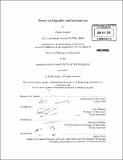| dc.contributor.advisor | Iván Werning and Ricardo Caballero. | en_US |
| dc.contributor.author | Kurlat, Pablo (Pablo Daniel) | en_US |
| dc.contributor.other | Massachusetts Institute of Technology. Dept. of Economics. | en_US |
| dc.date.accessioned | 2010-09-01T13:44:37Z | |
| dc.date.available | 2010-09-01T13:44:37Z | |
| dc.date.issued | 2010 | en_US |
| dc.identifier.uri | http://hdl.handle.net/1721.1/57999 | |
| dc.description | Thesis (Ph. D.)--Massachusetts Institute of Technology, Dept. of Economics, 2010. | en_US |
| dc.description | "June 2010." Cataloged from PDF version of thesis. | en_US |
| dc.description | Includes bibliographical references (p. 126-131). | en_US |
| dc.description.abstract | This dissertation studies the interaction of liquidity and incomplete or asymmetric information. In Chapter 1, I study a dynamic economy with illiquidity due to adverse selection in financial markets. Investment is undertaken by borrowing-constrained entrepreneurs. They sell their past projects to finance new ones, but asymmetric information about project quality creates a lemons problem. The magnitude of this friction responds to aggregate shocks, amplifying the responses of asset prices and investment. Indeed, negative shocks can lead to a complete shutdown in financial markets. I then introduce learning from past transactions. This makes the degree of informational asymmetry endogenous and makes the liquidity of assets depend on the experience of market participants. Market downturns lead to less learning, worsening the future adverse selection problem. As a result, transitory shocks can create highly persistent responses in investment and output. In Chapter 2, I study why firms can choose to be illiquid. Optimal incentive schemes for managers may involve liquidating a firm following bad news. Fragile financial structures, vulnerable to runs, have been proposed as a way to implement these schemes despite their ex-post inefficiency. I show that in general these arrangements result in multiple equilibria and, even allowing arbitrary equilibrium selection, they do not necessarily replicate optimal allocations. However, if output follows a continuous distribution and creditors receive sufficiently precise individual early signals, then there exists a fragile financial structure such that global games techniques select a unique equilibrium which reproduces the optimal allocation. In Chapter 3, I study speculative attacks against illiquid firms. When faced with a speculative attack, banks and governments often hesitate, attempting to withstand the attack but giving up after some time, suggesting they have some ex-ante uncertainty about the magnitude of the attack they will face. I model that uncertainty as arising from incomplete information about speculators' payoffs and find conditions such that unsuccessful partial defenses are possible equilibrium outcomes. There exist priors over the distribution of speculators' payoffs that can justify any possible partial defense strategy. With Normal uncertainty, partial resistance is more likely when there is more aggregate uncertainty regarding agents' payoffs and less heterogeneity among them. | en_US |
| dc.description.statementofresponsibility | by Pablo Kurlat. | en_US |
| dc.format.extent | 131 p. | en_US |
| dc.language.iso | eng | en_US |
| dc.publisher | Massachusetts Institute of Technology | en_US |
| dc.rights | M.I.T. theses are protected by
copyright. They may be viewed from this source for any purpose, but
reproduction or distribution in any format is prohibited without written
permission. See provided URL for inquiries about permission. | en_US |
| dc.rights.uri | http://dspace.mit.edu/handle/1721.1/7582 | en_US |
| dc.subject | Economics. | en_US |
| dc.title | Essays on liquidity and information | en_US |
| dc.type | Thesis | en_US |
| dc.description.degree | Ph.D. | en_US |
| dc.contributor.department | Massachusetts Institute of Technology. Department of Economics | |
| dc.identifier.oclc | 655854301 | en_US |
